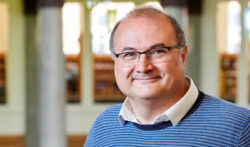Blog diary one: Using screen capture feedback
Written by Antonio Martínez-Arboleda
In the first of a five-part series of blog diaries, LITE Teaching Enhancement Project Leader, Antonio Martínez-Arboleda, explores the trials, tribulations and triumphs of using screen-capture feedback with his students.
Blog diary One: Screen-capture Feedback
We all agree that it is the needs and aspirations of students and educators that should be driving technological innovation, and not the other way round.
The tail should not wag the dog.
Sometimes, however, new tools offer unexpected yet exciting educational affordances that we must make the most of.
Fascination
This is the case with Desktop Capture, also known as Personal Capture.
Originally intended for teaching, it has, serendipitously, become a tool for the provision of feedback on student written work that opens up a wealth of opportunities for improving the quality of their learning.
I dare to say that this form of feedback has the potential to expose, and help to correct, some of the flaws of our current assessor-student relations and dynamics
That is why I am fascinated by it.

THE AUTHOR: Antonio Martínez-Arboleda.
How to
Providing screen-capture feedback is very simple:
a) The tutor brings up the work submitted by the student on the screen of her computer, typically in a Word document.
b) She activates a screen capture software (just a very few clicks) such as Mediasite or Jing.
c) Then she starts the recording, capturing both the work of the student on the screen and her own voice as it comments on the work.
d) The tutor can highlight in Word parts of the work that she is talking about and even bring in other relevant materials such as a website links to complement the comments. This is a form of bi-modality, or even tri-modality, as the oral text, the written text of the student and the visuals introduced by the tutor’s using the Word-processor tools support each other in the creation of meaning.
e) The possibility of pausing the recording offers the opportunity to think, consult, or take a break. This is not a live performance.
f) Once the video recording is complete, the tutor can authorise the student and the second marker and send the link to them.
Challenges
The day I first started to use screen-cast capture feedback in my own teaching, following the introduction of Mediasite Desktop Capture at Leeds, I felt that some tensions would have to be resolved and some wrinkles ironed out for this form of feedback provision to take off.
In a way, I had placed myself at a crossroads: I knew I was expected to produce written feedback, and written justification for my grading decisions, on top of the video-recording, but at the same time I wanted to maximise the opportunities provided by orality to elaborate my thoughts on the student work in an emotionally and educationally engaging manner.
I also wanted to make the production of feedback more efficient and more effective.
After more than two years, however, using screen capture feedback in one of my modules, I have discovered ways of by-passing the conventional written paths.
'Decoupling'
My sense of professional pride and liberation continues to grow as I embrace orality and multimodality.
I have also found that producing and providing feedback can be, as an educational activity, decoupled from “grading”, for the benefit of the students, my institution’s and my own.
This benefits the students, and informs the development of formative feedback for me and my institution.
By releasing the feedback first, and, a few days later, the mark, I allow students to concentrate on the feedback at an early stage while second examiners deal with my own marking.
Time and space to develop
Now, thanks to my recently awarded LITE Fellowship at Leeds, I will be able to study more in depth this topic.
It is time to put my experiences and my curiosity at the service of students and colleagues, at the University of Leeds and beyond, adding my own scholarship to the increasing efforts in this field by other practitioners across the world who have researched this topic.
I intend to look at this educational development in a very practical way, trying to find seamless user journeys for assessment and feedback.
I am conscious of the QA and administrative obstacles, but also committed to introducing much needed humanistic, linguistic and even political reflections into the debate on this crucial topic.
In my next blog post I will reflect on my informal conversations with colleagues on the topic of my teaching enhancement project and on other initiatives in the area of feedback and assessment at Leeds and beyond.
